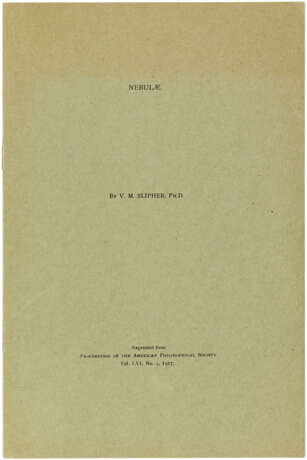ID 369997
Lot 8 | The universe is expanding
Valeur estimée
£ 4 000 – 7 000
Nebulae. [Offprint from Proceedings of the American Philosophical Society, v. lvi, n.5]. 1917.
Octavo (244 x 160mm), unblemished. Original printed wrappers. Provenance: Edwin Powell Hubble (astronomer, 1889-1953, his ownership inscription at foot of last page).
First edition, extremely rare offprint, remarkable association copy belonging to Edwin Hubble, of the paper which ‘provided the first evidence supporting the expanding-universe theory’ (Britannica). Slipher here charts his momentous observation: having examined 25 spiral ‘nebulae’, he had found that 21 are receding from us at high speeds. He anticipated Hubble in his two most important discoveries: that the universe is expanding, and that the nebulae are separate galaxies outside our own, implying that the universe is vastly larger than our own Milky Way galaxy.
Slipher’s velocity measurements were the (unacknowledged) data used by Hubble in 1929 as he published the law now named after him, stating that galaxies are receding from us at velocities proportional to their distance. Slipher here also draws the startling implication that we are not at rest, but rather that ‘our whole stellar system moves and carries us with it’ (p.7) .
‘In 1929, Hubble provided distance estimates for a sample of no greater depth [than Slipher’s], using redshifts due almost entirely to Slipher. Hubble’s distances turned out to be flawed in two distinct ways: in addition to an incorrect absolute calibration, the largest distances were systematically under-estimated. Nevertheless, he claimed the detection of a linear distance-redshift relation … This is undeniably a great irony: by combining Slipher’s effectively perfect velocity data with distance estimates that are so badly flawed, Hubble nevertheless routinely receives sole credit for the discovery of the expanding universe (including the assertion that he measured the redshifts, which is frequently encountered in popular accounts – and too often even in those written by professional scientists)’ (Peacock, ‘Slipher, galaxies, and cosmological velocity fields,’ in Origins of the expanding universe: 1912-1932, 2013, p.10). Slipher, ever cautious and reticent, never formally published the full set of his painstaking redshift measurements, but allowed them to be circulated by others. Hubble publicly acknowledged his debt in 1953.
Slipher was awarded the Gold Medal of the Royal Astronomical Society in 1933; the citation read: ‘In a series of studies of the radial velocities of these island galaxies, he laid the foundations of the great structure of the expanding universe, to which others, both observers and theorists, have since contributed their share’.
| Adresse de l'enchère |
CHRISTIE'S 8 King Street, St. James's SW1Y 6QT London Royaume-Uni | |
|---|---|---|
| Aperçu |
| |
| Téléphone | +44 (0)20 7839 9060 | |
| Commission | see on Website | |
| Conditions d'utilisation | Conditions d'utilisation |




